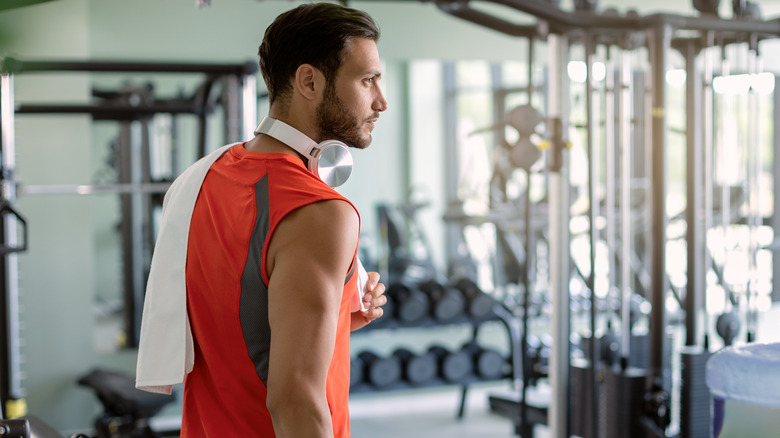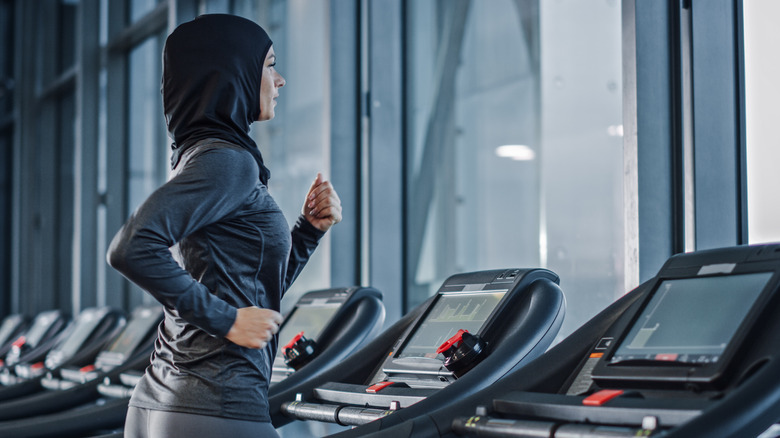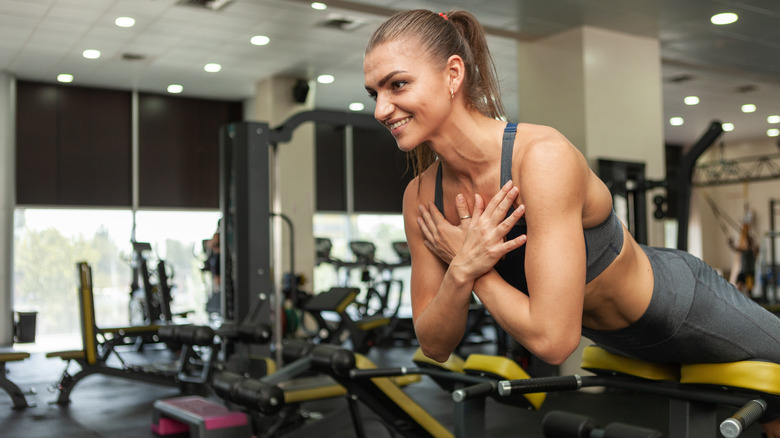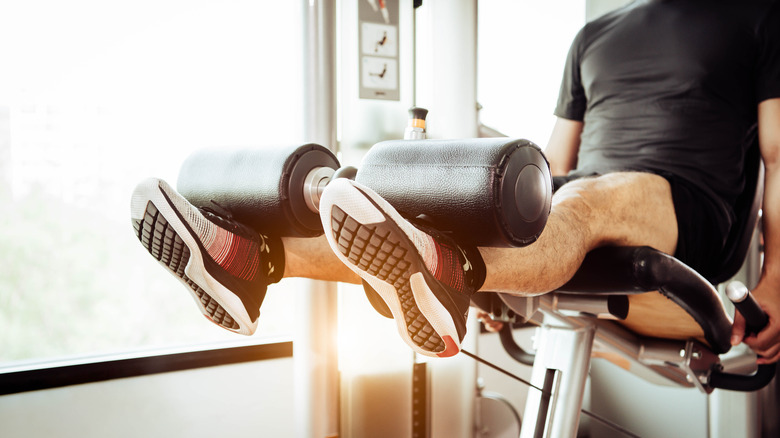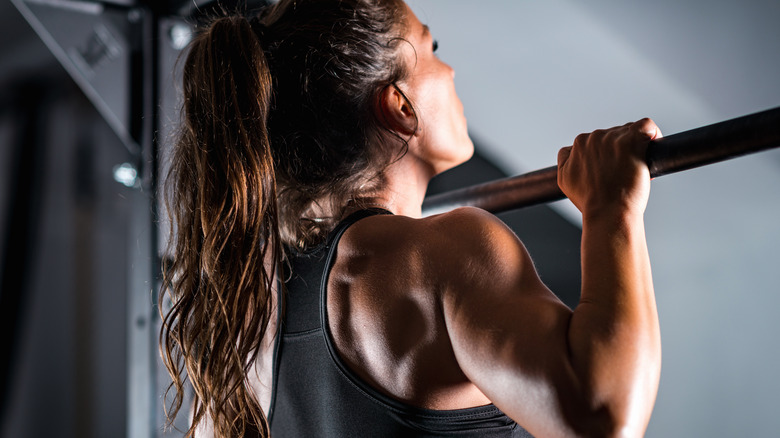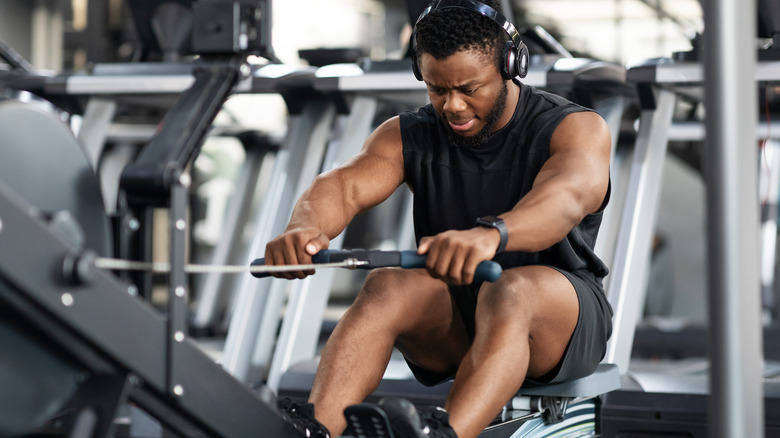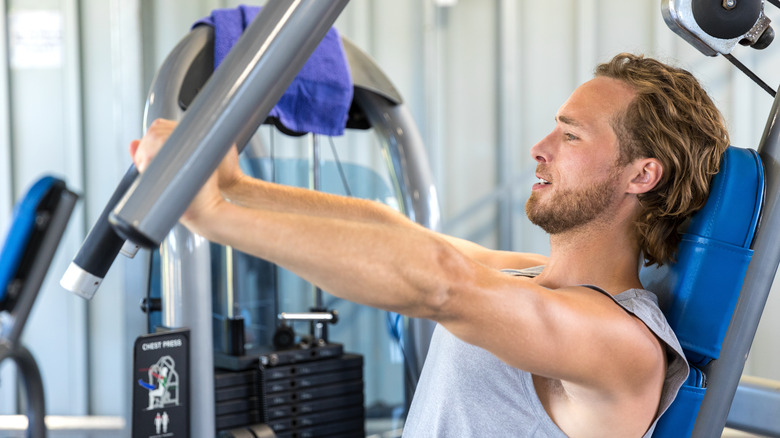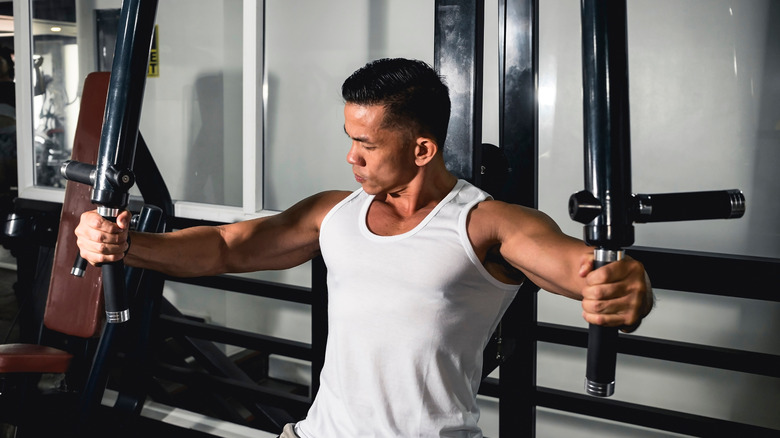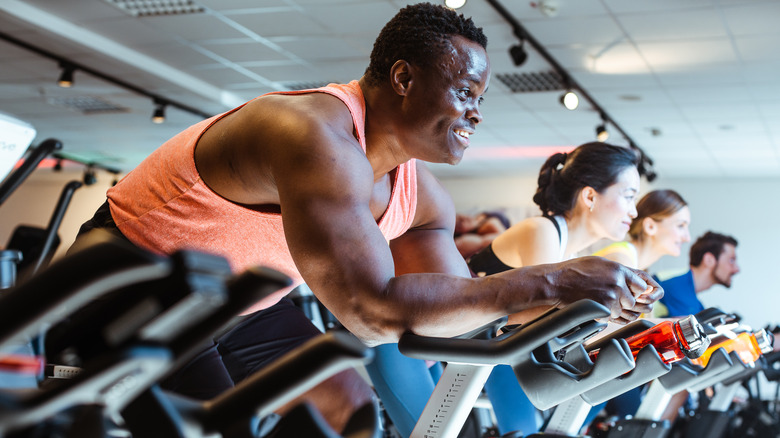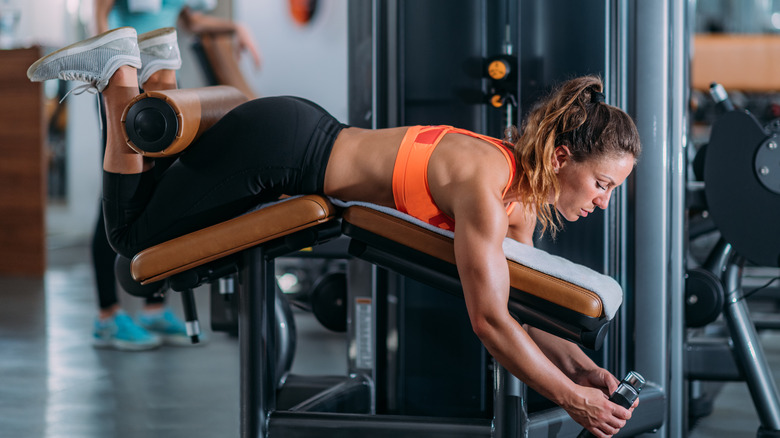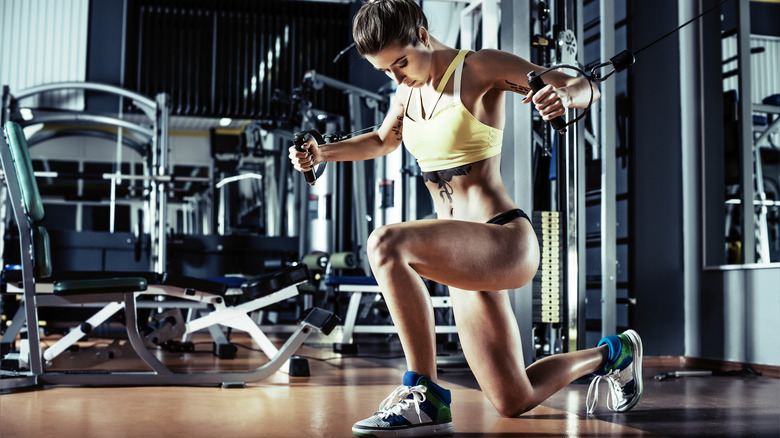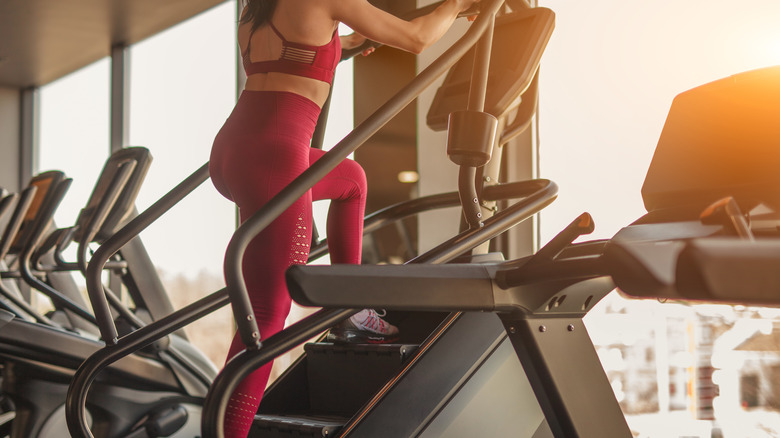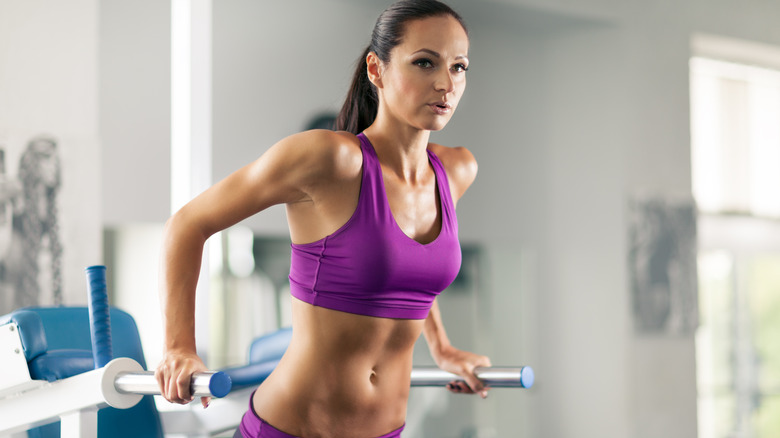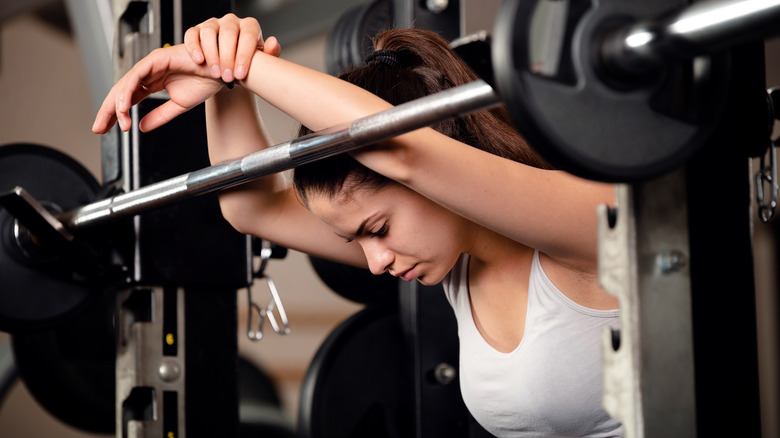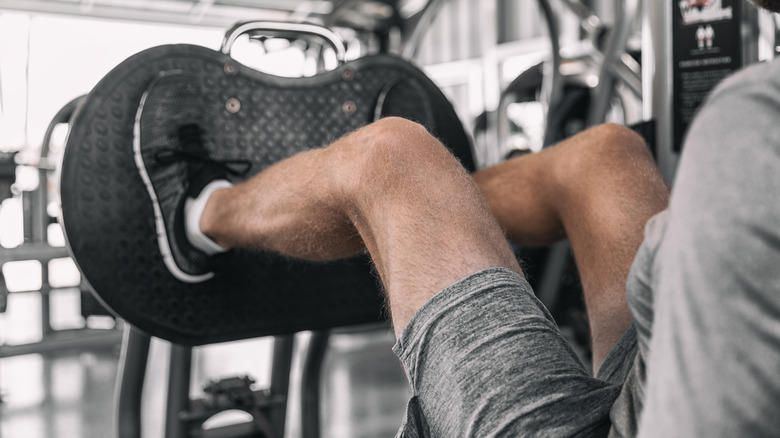Machines At The Gym You're Probably Not Using Correctly
Ever walked into a gym, looked around at the people using the machines, and thought "yeah, looks easy"? If so, you're probably not alone — but beware. While gym machines can offer you an efficient workout (and make you look like a total boss), they can lead to some pretty rough results and injuries if operated incorrectly. Indeed, in a study conducted in the U.K. by personal injury law firm Hayward Baker, two out of five people admitted to injuring themselves using machines at the gym (via Protectivity).
As such, "it's vital you understand how all the equipment works and that you know your limits," said a Hayward Baker spokesman. But frankly, it's all too easy to get yourself into bad habits using gym equipment, and if, like us, you're a little shy about asking your fellow fitness fanatics in the gym for help, we've got you covered. Here's a look at some of the popular machines you're likely using incorrectly.
Think the treadmill is easy? It causes a surprising amount of injuries
Few gym machines have as much lasting popularity as the treadmill, but few machines offer as much potential for injury either. According to 2016 data analyzed by Elliptical Reviews, almost 36% of gym injuries that ended in an ER visit involved a treadmill. That's 25% more than the next most dangerous piece of equipment (general exercise machine).
Injuries involving treadmills often occur due to the speed they're running at. "Picking an unrealistic speed can result in injury because you don't have the strength or efficiency in your cadence to maintain those speeds," Emily Hutchins, owner of On Your Mark and Nike Master Trainer, told The Healthy. To avoid this, start slow, particularly if you don't run regularly.
Listen to your stride and how much effort you're putting in, and only add speed when you're sure it won't overexert you. If you're really pounding the treadmill, it may be too fast, says Olivier Vancassel, a specialist in biomechanics, ultra-endurance running, and manager at Six Senses Spas at Nobu Hotel Ibiza Bay.
Your back extension machine exercises could be causing hyper-extension
If you're looking to build the muscles in your lower back, few machines are as efficient as a back extension machine. Unfortunately, it's also very easy to misuse this piece of equipment, potentially doing more harm than good to the area you're trying to target. "It is common to see people hyper-extending their bodies when using the 45-degree back extension machine," Tom Holland (not the actor, we checked), certified strength and conditioning specialist and exercise physiologist, told The Vitamin Shoppe. This hyper-extension, said Holland, "[places] unnecessary stress on the lower back."
Instead, when performing back extensions with this machine, make sure to avoid arching your lower back, both in starting position and when you're in the middle of the exercise, according to Verywell Fit. Only extend until your thighs and your back are level, and make sure to squeeze your glutei at the top of the exercise, for added support. Above all, make sure to take your movements slowly, and avoid jerking or rushing while performing the back extension, as this can cause strain to your back muscles and your spine.
Your knees are at risk in a leg extension machine
While leg extension machines can get the burn going into your quads, they can be murder on your knees if not using them right. "It's common to take reps too fast and extend all the way down so that your heels are almost to your butt, which only stresses your patella and anterior cruciate ligament (ACL)," Cris Dobrosielski, certified strength and conditioning coach and owner of Monumental Results in San Diego, California, told Daily Burn. You can be at particular risk of this if you have weak knees or participate regularly in sports that have lots of jumping or quick changes in direction, says Coach Magazine.
The solution? Start small. Work with a lighter weight, and build up from there once you're comfortable your knees don't feel at risk. It's always important to perform this exercise slowly and engage your quads while you're exercising, instead of trying to work the weight up with your feet. Dobrosielski also suggests trying to perform only the top three to six inches of the move, avoiding dropping into the down position too far or suddenly, to avoid injury.
Watch out when getting on and off the assisted pullup machine
Anyone who has tried and failed to do a pullup (who, us? Never!) knows it's an exercise you need to build up to. An assisted pullup machine can help with that, but the nature of the machine means that injuries are surprisingly likely before you're even doing the exercise, particularly to the uninitiated. This is due to the moving platform on the machine, Crunch fitness manager Xio Colon told Prevention. Colon says that getting on and off the platform can sometimes lead people to fall, because they don't know how much it moves with weight, causing injury.
So when you're getting off and on this machine, be extra careful. And if possible, get someone to spot you while using it. Once you're safely on the machine, reduce your chances of any other injuries with proper technique: Make sure your shoulders are back and down and keep them drawn inward as you pull up and release, advises Women's Health. Pause briefly at the top before lowering, and keep it slow and controlled.
Watch your form on the rowing machine
Like the idea of a V-shaped back worthy of an Olympic rowing champion? If you do, putting in the time on a rowing machine's a good place to start. But it's easy to muddle your way through a workout on a rowing machine, using completely incorrect form, without even realizing it. And this raises your chance for injury. By watching for several key mistakes that actual Olympic rower and five-time world champion Alex Gregory detailed to Men's Health, you'll be able to avoid this.
The first mistake, Gregory explained, is to focus on pulling the handle instead of using your legs to drive the movement. Make sure you're sitting up tall and not slumping, and avoid trying to move too quickly or putting the resistance up way too high before knowing what your body can take. Gregory suggests that setting a lower resistance can help you maintain consistency and form, improving your workout. Finally, make sure to avoid bending your knees before your arms straighten when recovering from the pulling/pushing movement. Move your arms first, then your knees.
Your neck and shoulders can suffer with seated bench press machines
Seated bench press machines bear a high potential for injury if using them incorrectly. "Misusing this machine has the potential to cause shoulder and neck issues," Doug McQuery of Physique 57 told The Healthy. This often comes down to the weight people use. Too often, people are "seated too low with their head jutting forward, a rounded spine, and elbows flared high," Crunch personal trainer Butch Sand told Prevention. This happens when your body's trying to overcompensate during the movement.
Instead, set a comfortable weight and work up, avoiding "explosive movement" and locking your elbows at the top, says Verywell Fit. If you find that your back is arching during this movement, reducing the weight can help with this. In addition, try to avoid moving your elbows too far back while holding the handles; this can cause hyperextension and injury to the shoulder joint. You should also make sure that your feet are placed firmly on the ground and the machine is well-adjusted so that your arms are horizontal to the floor when extended.
Your back could be rounding using the chest fly machine
Using a chest fly machine can be an excellent way to isolate your chest muscles without having to focus on keeping your balance, as Verywell Fit pointed out. Unfortunately, poor technique can not only make these machines less effective quite quickly, but it can also increase your chance of injury while using them. "I often see gym members using this machine while their upper back is rounded," Crunch personal trainer Allison Berry told Prevention. When this happens, your front shoulders take more of the strain of the exercise, increasing your chance of shoulder joint injuries and reducing the exercise that your chest is doing.
Instead, as Berry recommends, "Avoid injury by sitting tall, squeezing your glutes, and pressing your upper back firmly against the pad." Make sure your feet sit comfortably on the floor, and that your elbows and wrists are in line with your shoulders when performing the exercise. Make sure, crucially, to keep breathing and avoid the temptation to hold your breath — and if you feel any pain or strain while exercising, stop immediately and ask for assistance.
On an exercise bike? Make sure to adjust it first
Exercise bikes should be as easy as, well, riding a bike, right? (Forgive us, the joke was too hard to pass up.) While the motion itself might be simple, certain factors — like height adjustment — can cause your workout to become more difficult and potentially lead to painful after-effects. "If you've ever woken up the day after a cycling class and felt that not-so-great soreness in your hips and knees, sitting too low is likely the culprit," Jonathan Carlucci, a master spin instructor at Revolve Fitness, revealed to Shape. Plus, he continued, sitting too low can also limit the effectiveness of your workout by reducing the range of motion.
Make sure to check your height. "Once you're in the saddle, make sure you can reach the bottom of the pedal stroke with a slightly bent knee and flat foot," advised Kate Hickl, a master instructor and vice president of recruiting at Flywheel Sports. Also, make sure that you don't feel as though you're having to lunge for the handlebars or that you feel too squeezed in by them — set them at a comfortable height.
Keep the weight manageable on a hamstring curl machine
With your hamstrings involved in basically every leg movement you perform, keeping them strong is a must. A hamstring curl machine can certainly help with that, but incorrect use on the machine is frustratingly common. People frequently set the weight too high on a hamstring curl machine, which then results in them arching their backs and tilting their hips by pulling on the machine to use it, according to Doug McQuery, who runs digital product and business development at Physique 57 (via The Healthy). "This can cause both back and hamstring injuries," McQuery said.
A good way to know if the weight is too high is if you're having to resort to sudden or jerky movements to move it, Coach Magazine explained. If this is happening, drop the weight to a more comfortable level. Move slowly, and always make sure that the machine is adjusted correctly to keep your body in proportion. Your thighs and torso should rest be resting easily on the pads, and the pad against your legs should be sitting just below your calf muscles when your legs are extended.
Scared of the cable crossover machine? You're not alone
Ever been a little, well, intimidated by the cable crossover machine in the gym? If so, we're with you on that one. While these machines can do a lot of things, they can also be a little hard to suss out for newbies. "It's a very complex and versatile piece of gym equipment," Chris Finn, certified personal trainer at Life Time Athletic at Sky in New York City, told Greatist. "There are a lot of stations and a range of handles available to enhance its versatility, but this also causes a lot of confusion."
With confusion inevitably comes misuse, and with misuse comes lack of efficiency or injury. Finn explained that because of the cable crossover machine's ability to isolate muscle groups, people often add too much weight without realizing it, thus compromising technique. The golden rule is to never prioritize weight over form, as this can lead to a range of issues. "If you do the technique correctly, the weight will come, and nothing slows your progress more than getting hurt," confirmed Finn.
Stair climbers are not as simple as you think
On the surface, stair climbers seem simple to use. They emulate climbing stairs, so what could go wrong? Well, a fair amount, according to Tom Holland, certified strength and conditioning specialist and exercise physiologist. Few things make specialists like Holland more frustrated than draping their bodies over the display or handrails or setting the machine too high or worse, too low. "This turns it into more of an upper-body exercise and decreases the number of calories burned," he explained to The Vitamin Shoppe.
Instead, stand tall and set the machine at a reasonable height. Furthermore, "do not take the weight off your legs by leaning on the handrails. Apply only light pressure to balance yourself. Keep your shoulders back and look straight ahead," Mark Allison, fitness manager of 24 Hour Fitness Escondido North County Mall Club in Escondido, California, told Aaptiv. Drive through your heel instead of your toe to improve function, and never get on it while it's moving; start the machine once you're on it and keep the speed slow until you're sure you can handle it.
There's one exercise never to do on a power tower
The power tower is a versatile piece of equipment. In gyms across the country, you can find people performing all manner of exercises on them. One way not to use the power tower, however, is to perform hanging leg raises by propping yourself up on your forearms and hiking up your legs, Cris Dobrosielski, certified strength and conditioning specialist and owner of Monumental Results in San Diego, California, told Daily Burn. As Dobrosielski said, "These are just OK for ab strength, and they put a tremendous load on your lower back."
There are plenty of other ways to get an ab workout that are more efficient and less impactful on your lower back, he explained, like floor exercises like modified leg raises. Save the power tower for other exercises, like tricep dips, pullups, chin-ups, and even pushups (via Exercise.co.uk).
With a squat rack, positioning is everything
A squat rack isn't a machine, per se, but as gym equipment goes it's pretty easy to use incorrectly. When using a squat rack, it's all in the setup. And setting up the bar positioning in the wrong way can mean difficulty when you unrack the weight.
For those who are low bar squatters, you want to make sure that the bar lines up with the center of your chest so that your lats can be locked in under the bar before unracking, according to Women's Health. If you're craning upwards or feel as though you're on your tiptoes to unrack the weight, the bar is set too high.
Once you've unracked the weight, make sure you maintain good form during the squat to keep free of injuries. Avoid rounding your back during the movement and keep your core engaged throughout. And although trying to tackle too much weight at once is naturally an injury risk, squatting with too little weight can be pretty unproductive. Powerlifter Amanda Gisby told Women's Health that if you can do a calf raise while carrying your squatting weight, it's too light.
Using a leg press machine? You may not need as much weight as you think
As gym machines go, the leg press machine is potentially the one that resembles a modern-day torture device the most. However, you can maximize the pleasure you get from the machine by operating it correctly. Regrettably, though, leg presses can carry a fair risk of injury. "With a leg press, the lower back is at risk when you overload the weight," Rumble Boxing trainer Kory Flores confirmed to The Healthy.
Flores also warned of locking the knees when using a leg press, calling it "another common mistake that puts stress on joints instead of muscles." He continued, saying, "Make sure your knees stay in line with your toes, push your weight through your heels, and use a semi-challenging weight." It's also worth remembering that your foot positioning on the pad will dictate which muscles in your legs are activated more. To activate your glutes more, place your feet higher on the pad; if building your quads is what you're aiming for, position your feet lower on the pad (via Coach Magazine).
